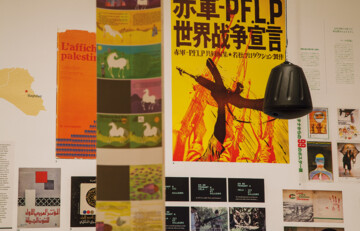The term “heterochronia”[1] tries to address the question of the politics of a time (chronopolitics) by looking into the relationships between language (→ representation, narratives), power, and temporality. This is both an epistemological question and a methodology for constructing history. Michel Foucault borrowed the term “heterochronie” from biological language in the lecture “Des spaces autres” [Other Spaces] (1967), and used it to interrogate the modern Western construction of time and its relationship with hegemonic historical narratives. Heterochronia does not refer to time as an abstract dimension of physics, but rather to time as a social and political → construction. Foucault thought of → archives, libraries, and museums as “heterochronias”, political dispositifs that “accumulate time”. A museum works as a time machine that configures chronological and visual fiction (Stephen Kern). What are the times that museums are accumulating? And what other times resist conventional narratives and reject accumulation as a historical method?
Building upon a critique of naturalised time already developed by Mikhail Bakhtin and Henri Lefebvre, Foucault’s notion opens up the possibility of understanding the museum as a collective abstract machine to construct “other times”, not only to question the storyline of the past but also to invent “other” futures. By claiming “other times”, this project focuses on those temporalities that suspend, neutralise or reverse the dominant narratives of art history: those coming from linguistic, national and political minorities, feminist and sexual “molecular” movements, as well as other modes of perception and cognition (disability movements).
Heterochronia relates to a series of concepts coming both from the art practices that arose after the 1960s, and also from political movements and critical theory: the notion of “chronopolitics” (Paul Virilio) stresses the links among capitalism, technology, and temporal production; ephemerality and performativity can be understood as “operations within time” (Judith Butler), modernity as a “time in ruins” (Marc Augé); anachrony as the “opening up of history” (Georges Didi-Huberman) and the political → intervention as the possibility to “switch → temporalities” (Jacques Rancière); → the “contemporary” as a site of experimentation with multiple times (Giorgio Agamben); and “unproductive time” as a strategy to resist “acceleration” as the dominant time of modernity (Harmut Rosa).
Heterochronic reading as a historical method is an effort to produce “situated knowledge” (Donna Haraway) to subvert history in terms of a single thread of linear time (“the time of progress and the time of the winners” – Walter Benjamin) and to critically engage into a proliferation of (vertical or fractal) layers of time that fight to produce other histories.

Past Disquiet: Narratives and Ghosts from The International Art Exhibition for Palestine, curated by Rasha Salti & Kristine Khouri, exhibition view, Museu d’Art Contemporani de Barcelona, 2014. Photo courtesy of MACBA.
We are currently exploring this critical methodology at the Museu d’Art Contemporani de Barcelona – MACBA with the exhibition project Past Disquiet: Narratives and Ghosts from The International Art Exhibition for Palestine curated by Rasha Salti and Kristine Khouri. The International Art Exhibition for Palestine was inaugurated in Beirut (Lebanon), in March 1978, and was intended as the seed collection for a museum in exile. Inspired by the Museo de la Solidaridad Salvador Allende (1971–73), or Museum of → Solidarity Salvador Allende, the museum took the form of an itinerant exhibition that was meant to tour until it could “repatriate” to Palestine. During the Israeli siege of Beirut in 1982, sustained heavy shelling destroyed the building where the works were stored as well as the exhibition’s archival and documentary traces. Incarnating the multiple themes and interrogations that have guided the resulting investigation, Past Disquiet will stitch together forgotten histories and map lost cartographies from recorded testimonies and private → archives. Past Disquiet interrogates exhibition history and the historiography of artistic practice and perception, and will also address the problematics of oral history, the trappings of memory, and writing history in the absence of cogent archives. The project will furthermore revisit the significance of political engagement in the 1970s, specifically in universes neither deemed vanguard nor mainstream, and thus rarely studied in prevailing contemporary historical narratives.
Bibliography
- Bakhtin, Mikhail. Rabelais and His World. Bloomington: Indiana University Press, 1984.
- Benjamin, Walter. “Thesis on the Philosophy of History”. In Illuminations: Essays and Reflections. London: Schocken, 1969.
- Didi-Huberman, Georges. Devant le temps: Histoire de l’art et anachronisme des images. Paris: Minuit, 2000.
- Foucault, Michel. “Of other spaces”. Diacritics 16 (1986): 22–27.
- Foucault, Michel. “Space, Knowledge, and Power”. In Power: The Essential Works 3, edited by J. Faubion, 349–364. London: Penguin, 2000.
- Horder, Tim. “Heterochrony”. In Encyclopedia of Life Sciences. Chichester: John Wiley & Sons, 2006.
- Kern, Stephen. The Culture of Time and Space: 1880–1918. Cambridge: Blackwell, 1983.
- Lefebvre, Henri. The Production of Space. Cambridge: Blackwell, 1983.
- Rosa, Harmut. Social Acceleration: A New Theory of Modernity. New York: Columbia University Press, 2013.
- Ross, Christine. The Past is the Present; It’s the Future Too: The Temporal Turn in Contemporary Art. New York: Continuum, 2012.
- Sturken, Marita. “Imaging postmemory/renegotiating history”. Afterimage 26, no. 6 (2013).
- Virilio, Paul. Speed and Politics. Semiotext(e). New York, 1986.



